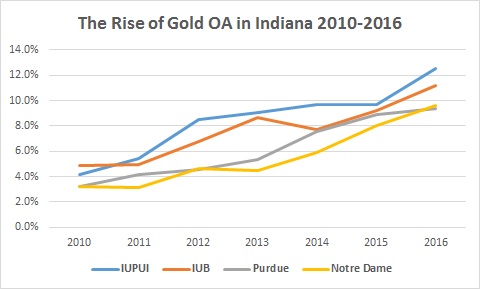Have you ever wondered if any authors on your campus are choosing open access journals for their articles? Or, if you've seen a few OA journal articles with your faculty members listed as authors, have you wondered how much of the campus article literature is published in OA journals?
Sadly, these are not easy questions to answer. The most thorough and accurate approach would be review the university's bibliography as reported by its authors in an annual review system of some sort. But, unless you're on a relatively small campus, that could be a tedious process. Authors frequently mis-cite their own works in these systems and the work of verifying the status of each article and each journal would probably dissuade most librarians from taking this approach.
There are, however, less accurate, but much easier ways to get a quick estimate. First, if you have access to the Scopus database, you can run an institutional search and cross-index your results with the DOAJ. I've done this a couple times and it takes a few hours. (I'll share my methods in a future post.) This approach is limited by the OA journals that Scopus chooses to index--an incomplete set of DOAJ titles. For better or worse (mostly better), it also misses the OA journals that have not met the standards or have not applied for inclusion in the DOAJ.
Thankfully, there's a much quicker, but also less accurate, approach to estimating your university's Gold OA literature. Like Scopus, Web of Science provides an affiliation search field. If you run an affiliation search for your university, you can limit your results to OA journals. By comparing these two numbers, you can get an estimate of your university's OA portion. Of course, the downsides here are the same that you have with the Scopus approach, but more so. Web of Science includes only about 1,313 of the journals in the DOAJ's current list of 9,181 titles. Likewise, Web of Science will miss several pay-walled journals that your faculty likely choose for their articles. So, using the Web of Science search can only show the OA portion of your campus's articles indexed in Web of Science. But, as I said, it's quick and easy.
It's so quick and easy that you'll want to take it a step or two further and track the rise of OA year by year or, perhaps, compare your campus with others. That's what I've done here and that's why I'm declaring that IUPUI is the most open access friendly university in the state of Indiana. IUPUI authors a greater portion of its journal article literature in OA journals than both IU Bloomington and Purdue.
| 2010 | 2011 | 2012 | 2013 | 2014 | 2015 | 2016 | |
|---|---|---|---|---|---|---|---|
| IUPUI OA/All | 79/1919 | 109/1999 | 172/2017 | 190/2104 | 232/2390 | 226/2341 | 208/1655 |
| IUB OA/All | 97/2003 | 100/2009 | 136/2006 | 176/2031 | 182/2370 | 214/2314 | 175/1569 |
| Purdue OA/All | 112/3527 | 158/3789 | 176/3844 | 204/3801 | 298/3942 | 360/4052 | 275/2935 |
| Notre Dame OA/All | 39/1212 | 44/1438 | 71/1555 | 74/1643 | 97/1657 | 131/1629 | 120/1246 |
Search date: 20-Oct-16 (OG=(Indiana University-Purdue University Indianapolis)) AND DOCUMENT TYPES: (Article) (OG=(Indiana University Bloomington)) AND DOCUMENT TYPES: (Article) (OG=(Purdue University)) AND DOCUMENT TYPES: (Article) (OG=(University of Notre Dame)) AND DOCUMENT TYPES: (Article) | |||||||
In 2016 IUPUI is on track for publishing 13% of its articles in OA journals, while IUB is headed for 11%, Notre Dame for 10%, and Purdue for 9%. 
The good news for readers everywhere is that this rate is on the rise at all three campuses and has more than doubled since 2010. And that's worth celebrating! Happy OA Week 2016 Indiana!
-- Jere Odell (first posted 10/27/2016; updated 11/10/2016 to include Notre Dame)
